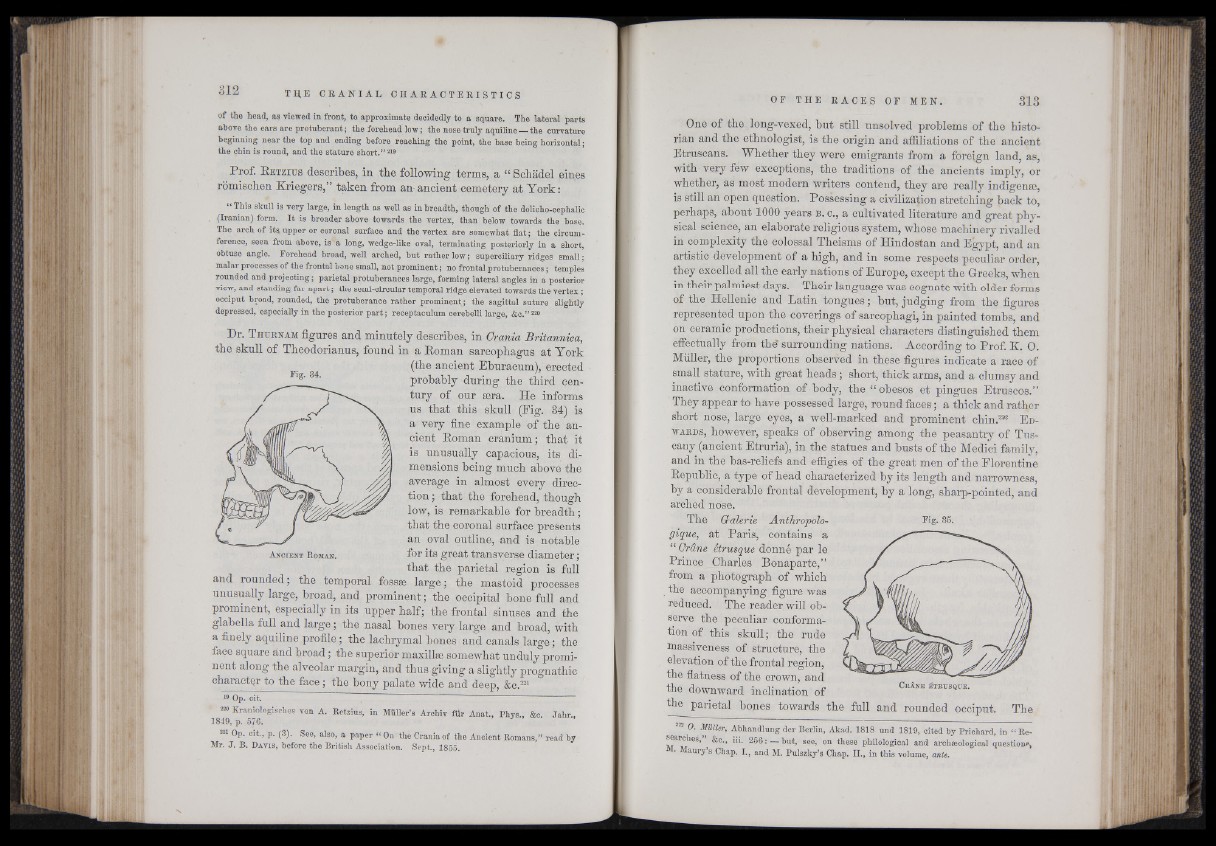
of the head, as viewed in front, to approximate decidedly to a square. The lateral parts
above the ears are protuberant; the forehead'low; the nose truly aquiline— the curvature
beginning near the top and ending before reaching the point, the base being horizontal;
the chin is round, and the stature short.” 219
Prof. R e t z iu s describes, in the following terms, a “ Schädel eines
römischen Kriegers,” taken from an ancient cemetery at York;
“ This skull is very large, in length as well as in breadth, though of the dolicho-cephalic
(Iranian) form. It is broader above towards the vertex, than below towards the base.
The arch of its upper or coronal surface and the vertex are somewhat flat; the circumference,
seen from above, is 'a long, wedge-like oval, terminating posteriorly in a short,
obtuse angle. Forehead broad, well arched, but rather low; superciliary ridges small;
malar processes of the frontal bone small, not prominent; no frontal protuberances; temples
rounded and projecting; parietal protuberances large, forming lateral angles in a posterior
view, and standing far apart; the semi-circular temporal ridge elevated towards the vertex;
occiput broad, rounded, the protuberance rather prominent ; the sagittal suture slightly
depressed, especially in the posterior part; receptaculum cerebelli large, &c.” 220
Dr. T hurnam figures and minutely describes, in Crania Britannica,
the skull of Theodorianus, found in a Roman sarcophagus at York
(the ancient Eburacum), erected
probably during the third century
of our sera. He informs
us that this skull (Pig. 34) is
a very fine example of the ancient
Roman cranium; that it
is unusually capacious, its dimensions
being much above the
average in almost every direction;
that the forehead, though
low, is remarkable for breadth;
that the coronal surface presents
an oval outline, and is notable
for its great transverse diameter;
that the parietal region is full
Fig. 34.
A n c ie n t R oman .
and rounded; the temporal fossse large; the mastoid processes
unusually large, broad, and prominent; the occipital bone full and
prominent, especially in its upper half; the frontal sinuses and the
glabella full and large; the nasal bones very large and broad, with
a finely aquiline profile; the lachrymal bones and canals large; the
face square and broad; the superior maxill® somewhat unduly prominent
along the alveolar margin, and thus giving a slightly prognathic
character to the face; the bony palate wide and deep, &c.m
19 Op. cit. " " ~ | ¡j ~ : _
220 Nraniologisches von A. Retzius, in Müller’s Archiv für Anat., Phys., &c. Jahr.,
1849, p. 576. J ’
m Op. cit., p. (3). See, also, a paper “ On the Crania of the Ancient Romans,” read by
Mr. J . B. Da v is , before the British Association. Sept., 1855.
One of the long-vexed, but still unsolved problems of the historian
and the ethnologist, is the origin and affiliations of the ancient
Etruscans. Whether they were emigrants from a foreign land, as,
with very few exceptions, the traditions of the ancients imply, or
whether, as most modern writers contend, they are really indigense,
is still an open question. Possessing a civilization stretching back to,
perhaps, about 10 0 0 years b . c., a cultivated literature and great physical
science, an elaborate religious system, whose machinery rivalled
in complexity the colossal Theisms of Hindostan and Egypt, and an
artistic development of a high, and in some respects peculiar order,
they excelled all the early nations of Europe, except the Greeks, when
in their palmiest days. Their language was cognate with older forms
of the Hellenic and Latin tongues ; but, judging from the figures
represented upon the coverings of sarcophagi, in painted tombs, and
on ceramic productions, their physical characters distinguished them
effectually from the' surrounding nations. According to Prof. K. 0.
Müller, the proportions observed in these figures indicate a race of
small stature, with great heads ; short, thick arms, and a clumsy and
inactive conformation of body, the “ obesos et pingues Etruseos.”
They appear to have possessed large, round faces ; a thick and rather
short nose, large eyes, a well-marked and prominent chin.2*3 E dwards,
however, speaks of observing among the peasantry of Tuscany
(ancient Etruria), in the statues and busts of the Medici family,
and in the bas-reliefs and effigies of the great men of the Florentine
Republic, a type of head characterized by its length and narrowness,
by a considerable frontal development, by a long, sharp-pointed, and
arched nose.
The Galerie Anthropolo- IjSfj 35.
gique, at Paris, contains a
“ Crâne étrusque donné par le
Prince Charles Bonaparte,”
from a photograph of which
the accompanying figure was
reduced. The reader,will observe
the peculiar conforma^
tion of this skull; the rude
massiveness of structure, the
elevation of the frontal region,
the flatness of the crown, and
the downward inclination of C e a n e é t e u s q u e .
the parietal bones towards the full and rounded occiput. The
222 Abhandlung der Berlin, Akad. 1818 und 1819, cited by Prichard, in “ Re-
6arc eé, &c., iii. 256 : — but, see, on these philological and archaeological question**,
• Maury’s Chap. I., and M. Pulszky’s Chap. n ., in this volume, ante.